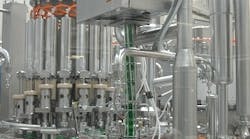Bunts and scratch singles are fine, but for some, nothing short of a grand slam will do.
The baseball analogy applies to beverage filling. A number of newer technologies are helping manufacturers realize incremental improvements, but some players are holding out for game changers.
Low-power electron beam was an example of the former. A system originally designed to sterilize medical devices from Advanced Electron Beams (AEB) was re-engineered for high-speed beverage filling lines in 2009. The beam only penetrated 200 microns, but that was enough for bottle caps, and operating cost was lower than peracetic acid by a factor of six, the firm claimed.
Despite business relationships with Shibuya and other OEMs, the system failed to attract enough users, and AEB withdrew from the market.
Pulsed light has fared better. It takes advantage of the germicidal effect of the ultraviolet segment of the electromagnetic spectrum. Pulsed light was pioneered in Japan almost half a century ago and relies on a xenon flash lamp to deliver short (0.3 millisecond), intense bursts of light to disrupt the DNA of any living organisms on a material’s surface.
The benefits are similar to low-beam electron: elimination of chemical sterilants and the need to heat water and dispose of the waste stream. The difference is pulsed light’s acceptance by beverage companies in recent years.
Nestle Waters used pulsed light in plants in the Philippines and Saudi Arabia in this century’s early years, but installations weren’t sufficient to sustain the supplier. Some staffers, including R&D director Christophe Riedel, established Claranor SA in Avignon, France, in 2004. Five years later, they had seven installations; today, more than 150 systems units are sterilizing packaging materials worldwide.
Pulsed light sterilizes caps on a juice filling line at Vilsa Brunnen, a German bottler of spring water and other beverages. The system sterilizes the entire cap on high-speed lines, helping to bring extended shelf life dairy products to 65-day shelf life. Photo: Claranor SA
Only 15 of those systems can be found in North America, primarily at dairy processors, according to Bryant Brackman, sales manager at Fort Loramie, Ohio-based Industrial Machining Services Inc. Dairy also happens to be the food processing segment where IMS’s sanitary processes division does most of its work. The firm has integrated some of those systems, easing the way to a formal partnership in March.
According to Riedel, who now serves as Claranor’s president, “We have performed thousands of microbial trials and have published (our) first scientific papers about the relationship between pulsed-light dose and response in log reduction.”
Assurances from microbiologists are well and good, but parts and support services are critical to meet production schedules. An earlier U.S. partnership proved a poor fit, but Riedel believes the dairy orientation of both IMS and filler OEM Serac should increase North American deployments.
While at Kraft Foods in the 1990s, Michael Richmond collaborated with university researchers on pulsed light. “We never got it to where we wanted it,” recalls Richmond, now vice president-packaging technology integrated solutions at Havi Global Solutions, a Downers Grove, Ill., consulting firm. “There may be some savings” from state-of-the-art pulsed-light systems, he allows, but the Fortune 500 beverage companies he works with are focused on “bigger transformational changes.”
Billion-dollar cost reductions are sought when mergers like the one between Kraft and H.J. Heinz occur, Richmond continues, and that can only come from game-changing shifts. The trend away from bottles and other rigid containers to pouches and other flexible containers exemplifies those types of shifts.
A trailer of rollstock film can satisfy the packaging needs of 13 trailers of bottles, he estimates, and distribution costs of finished goods also are significantly lower. OEMs are developing rotary fillers that will double line speeds for flexible containers, adding to the savings calculus.
Aseptic processing and filling also is poised for explosive growth, Richmond believes, if only because “97 percent of people being born live in developing countries” where cold-chain distribution isn’t feasible. Hydrogen peroxide and peracetic acid are the only FDA-approved sterilants for aseptic packaging materials, but OEMs of rotary fillers will be introducing new technologies within a few years.
Although Clarinor’s pulsed-light technology can only attain a 5 log reduction, researchers are focused on improvements that would boost microbial kill to the level needed for aseptic. That kind of improvement might be considered a Texas leaguer, but it’s always good to have runners on base when a filler OEM clubs a homer.


